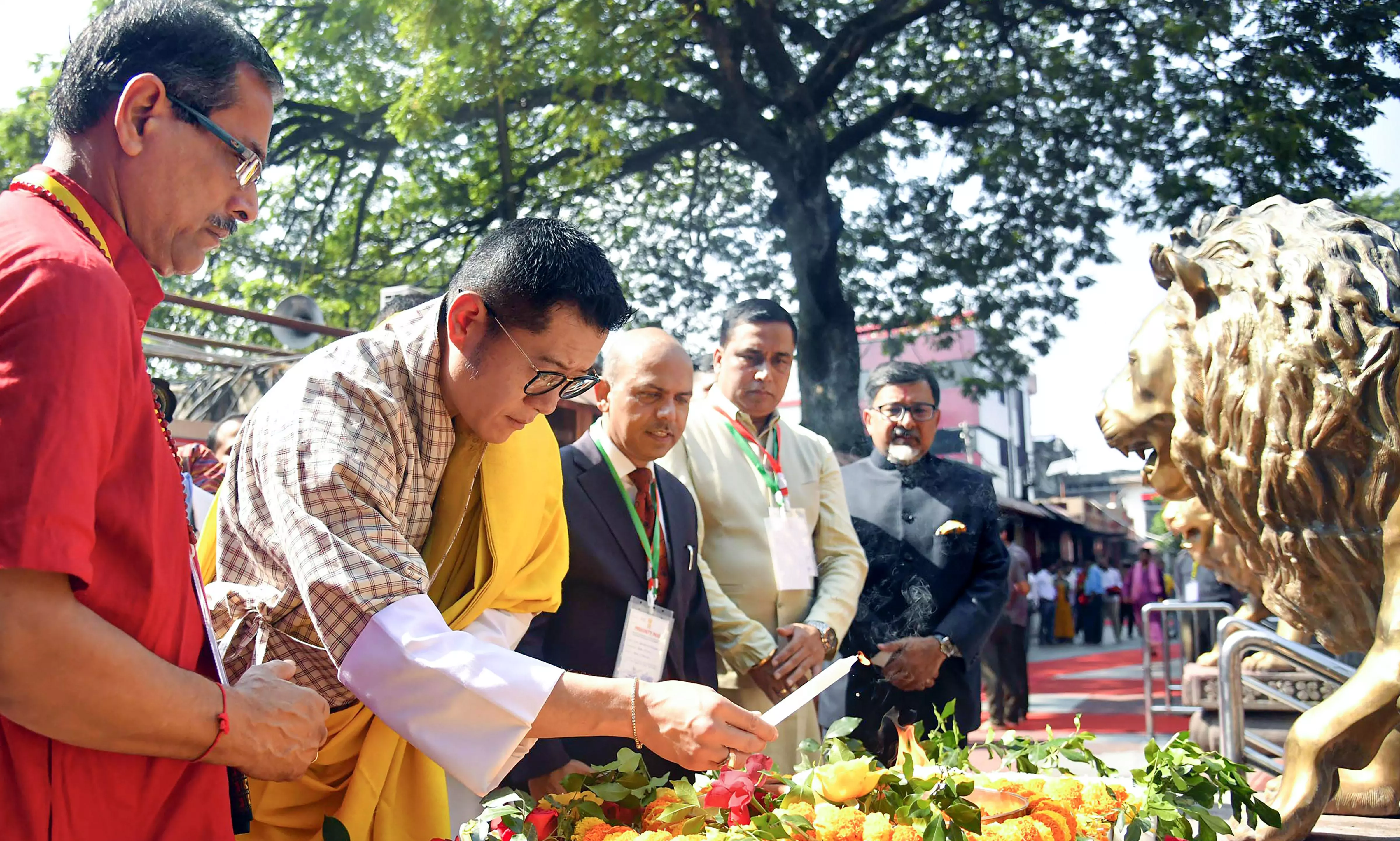
King of Bhutan Jigme Khesar Namgyel Wangchuck offers prayers at the Kamakhya Temple, in Guwahati, on Nov 3, 2023. Pic: PTI
Border bonhomie: Bhutan King's visit comes amid talks with China
Will New Delhi try and mend possible repercussions of Thimphu-Beijing negotiations?

Bhutan King Jigme Khesar Namgyel Wangchuck, on his second official trip to India in a year, is here for a week from November 3. Besides meeting Prime Minister Narendra Modi and External Affairs Minister S Jaishankar in New Delhi, he will also visit the states of Assam and Maharashtra.
The visit assumes importance in the backdrop of the renewed impetus with which China and Bhutan are striving to expedite their long-standing boundary talks. It was only last month, Tandi Dorji, Bhutan's foreign minister's visited China to speed up their boundary deals, which had not taken place for the last seven years.
Bhutan has said it is keen for an early settlement of the boundary issue with China and move towards establishing diplomatic relations. And, in August, China and Bhutan agreed for a 'three-step road map' to solve their festering border dispute.
Therefore, India is watching these developments with great interest as the outcome of the boundary row between China and Bhutan will have implications on New Delhi's security interests.
In fact, India and China were locked in a 73-day stand-off in 2017 at the Doklam tri-junction, after China tried to extend a road in that area that Bhutan claimed belonged to it. India supported Bhutan's claim at that time and objected to the construction since it would have jeopardised its overall security interests.
Following several rounds of talks, the India-China face-off was resolved.
Long-trusted neighbour
India and Bhutan, who established formal diplomatic relations in 1968, share a cordial relationship for years. And, Bhutan is regarded as a "long-trusted neighbour" by India.
The relationship between the two countries is governed by the Indo-Bhutan Friendship Treaty of 1949, which was later updated in 2007. According to the MEA, this treaty is the “basic framework” of India and Bhutan’s relations. It lays emphasis on “perpetual peace and friendship, free trade and commerce, and equal justice to each other’s citizens” between India and the Himalayan kingdom.
The revision in the treaty in 2007 involved tweaking the sentence which earlier said that Bhutan would be guided by India “in regard to its external relations” was changed to the two sides will cooperate “closely with each other on issues relating to their national interests”. However, according to reports, the article also states that neither the Bhutanese government nor its Indian counterpart will use its territory for “activities harmful to the national security and interest of the other”.
Bhutan King's agenda in India amid China bonhomie
As India is not only Thimphu’s “main development partner” but also its top trade partner, the Bhutan King is expected to have talks on sustainable trade, while also exploring collaboration on start-ups, STEM education, and space.
But, this visit assumes significance since his visit comes just a few weeks after Bhutan and China held the 25th round of boundary talks in Beijing.
News reports quoting Bhutanese foreign minister Tandi Dorji said that Thimphu was ready to conclude the boundary negotiations and speed up the process to set up diplomatic ties with China. Currently, Bhutan has no diplomatic relations with China.
Impact on India
Bhutan’s border talks with China hold strategic and security interests for New Delhi. The Doklam plateau, which India considers an undisputed territory of Bhutan, is of strategic importance because of its proximity to Siliguri Corridor.
Also known as Chicken’s Neck, the Siliguri Corridor is a 22km stretch connecting the Indian mainland to the Northeast. It also links India with Tibet, Nepal, Bhutan, and Bangladesh.
There are concerns in New Delhi that a border deal between Thimphu and Beijing could include swapping Doklam – located close to the tri-junction between India, Bhutan and China – for disputed territories in the north.
This trijunction point lies at a spot called Batang La. China wants to shift this point about 7 km south of Batang La to a peak called Mount Gipmochi. However, New Delhi is opposed to the move as that would mean the entire Doklam plateau would be under Beijing’s control.
With China pushing Bhutan to establish diplomatic ties and the two countries moving closer to settling their decades-old boundary dispute, India is wary and monitoring the developments closely.
However, though India views this China-Bhutan deal as “a severe strategic setback” to India’s Himalayan security undertaking, according to international reports, it seems unlikely that Bhutan would act without having support for its plans from India.
Others have pointed to statements by senior Bhutanese officials that firmly indicate that no decision will be made on the Doklam border area, which is of strategic value to India, without a trilateral discussion.
Long-standing development partner
Besides the Bhutan-China border issue, Bhutan has sought help from India. India supports Bhutan as it undergoes massive political, administrative and economic reforms, and seeks assistance for the 13th Five Year Plan (2023-2028). And has provided special assistance to Bhutan during the COVID-19 pandemic.
For various multi-sectoral projects, small development projects, and direct budgetary support, India has provided Rs 4500 crore to Bhutan's XII five-year plan (2018-23).
Significant cooperation between the two countries has also occurred in the hydro-power sector. On the connectivity front, India was considering setting up the first Integrated Check Post (ICP) on the India-Bhutan border, and also expedite the proposed Kokrajhar-Gelephu rail link project.
Next Story

